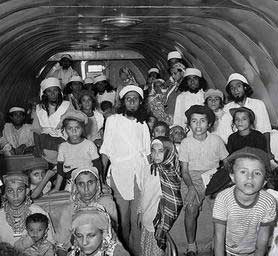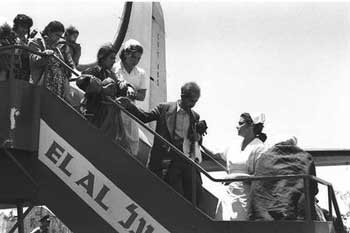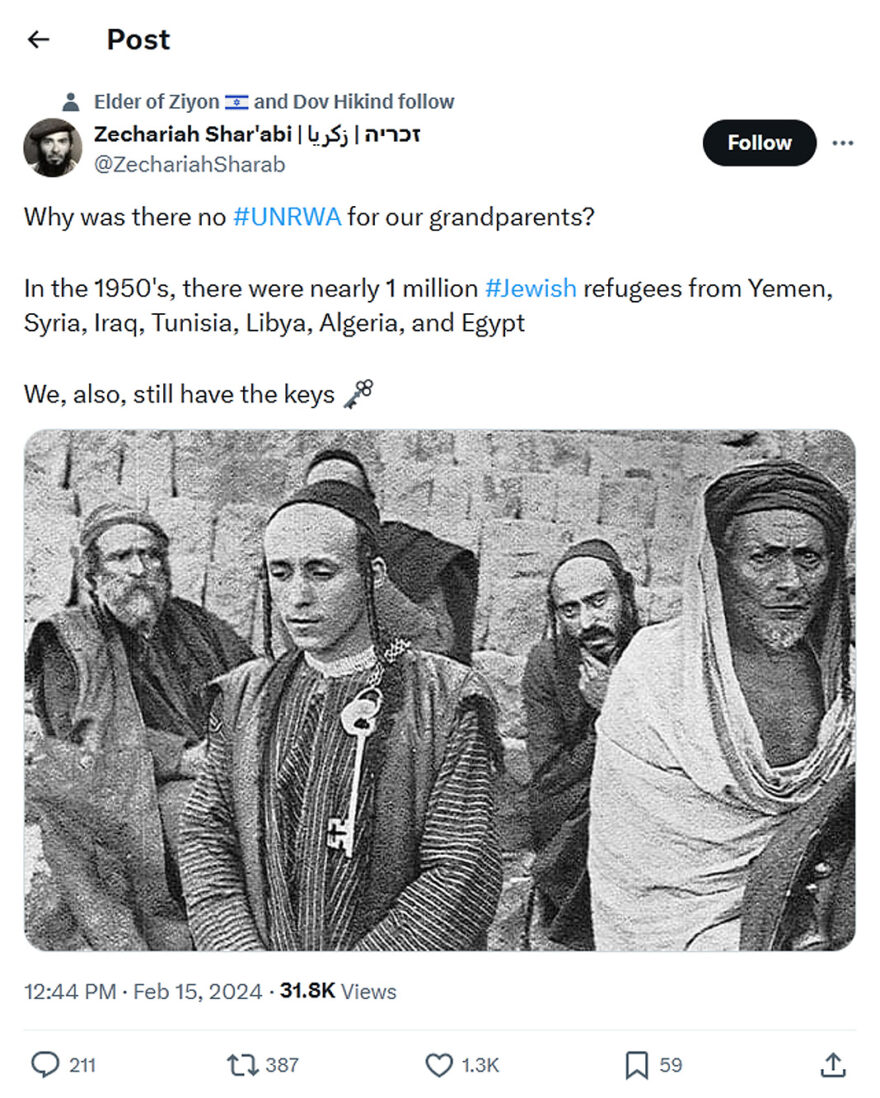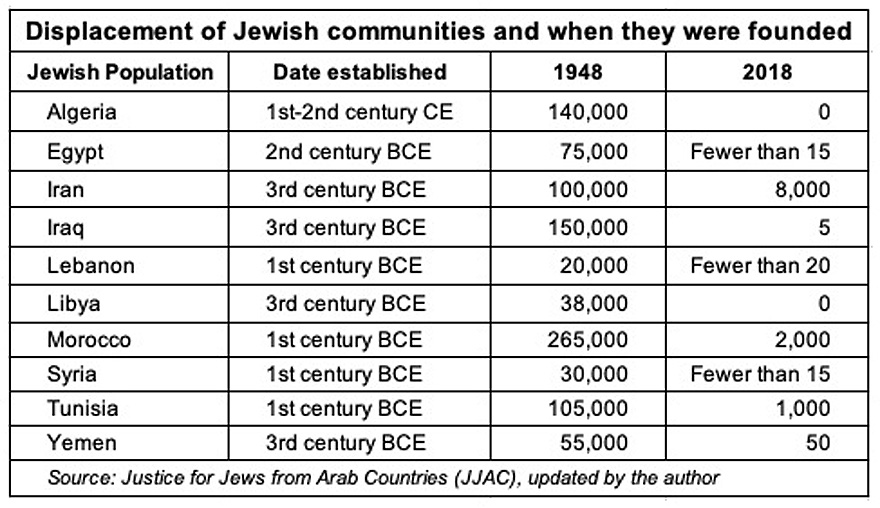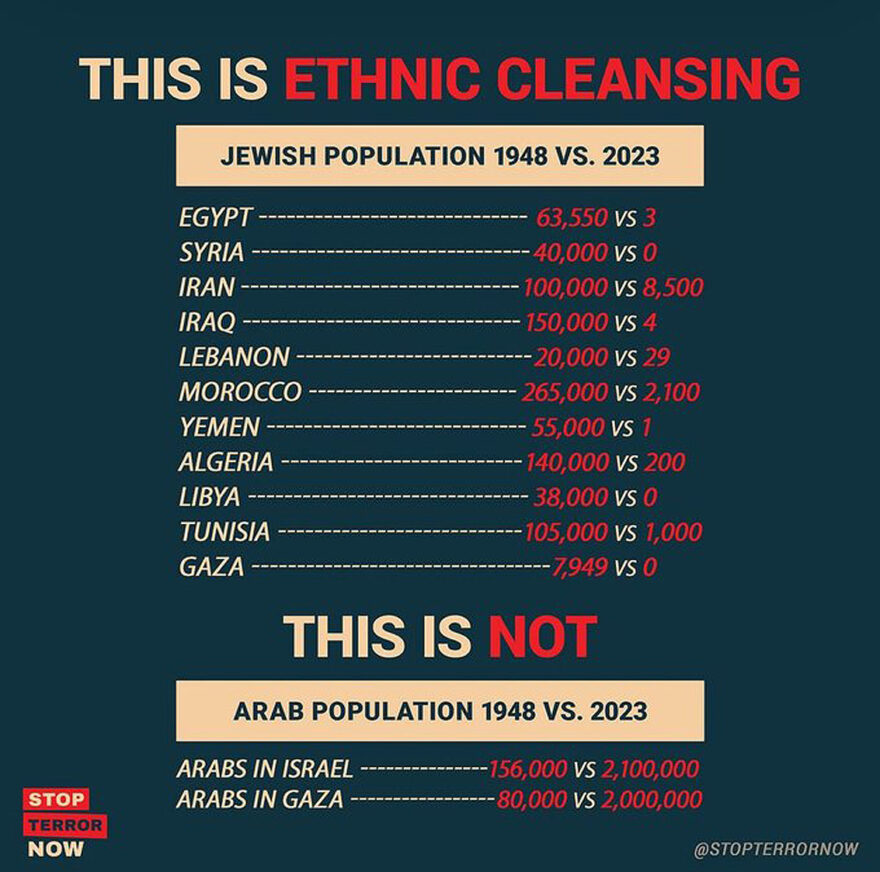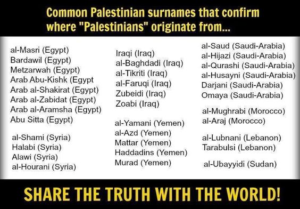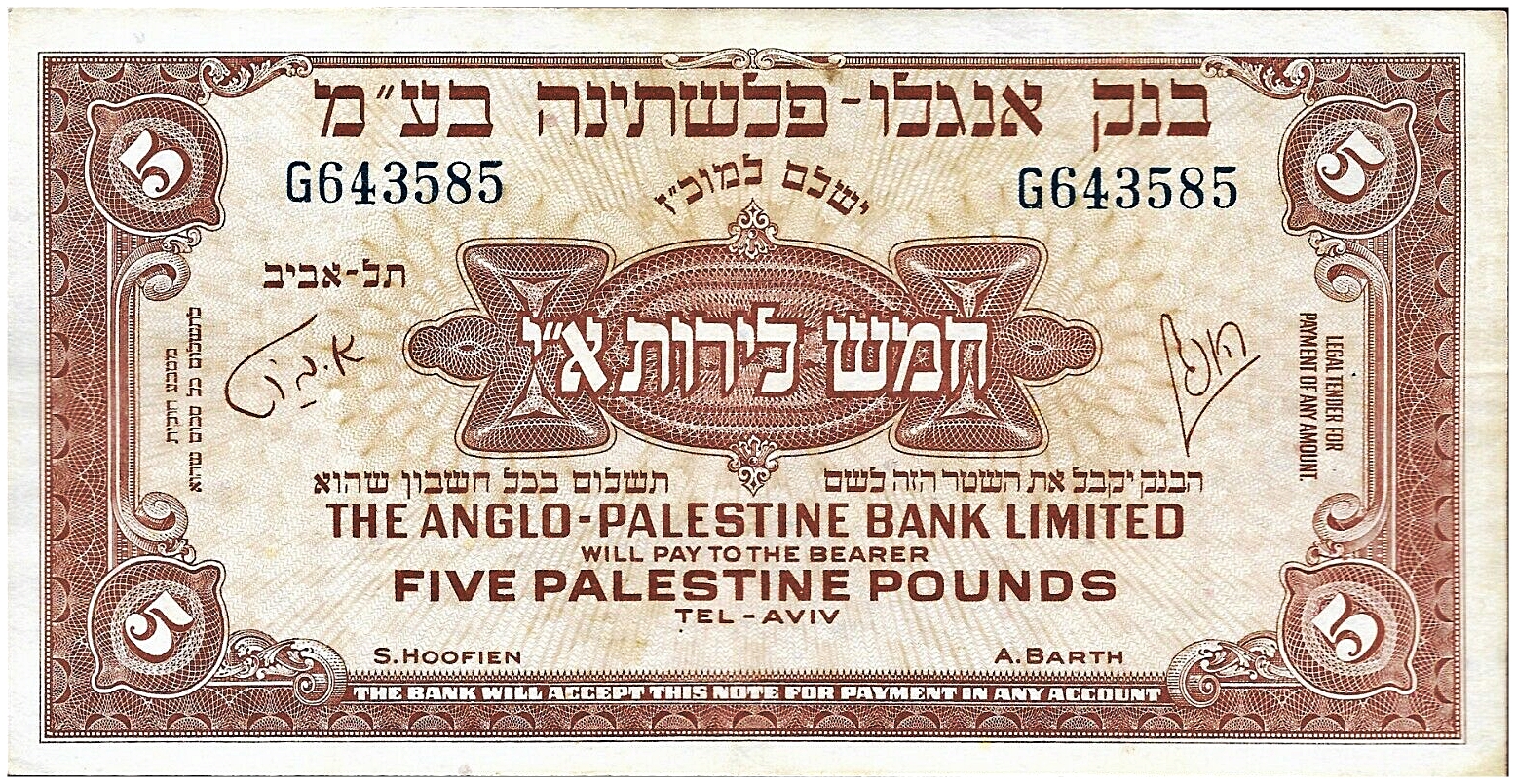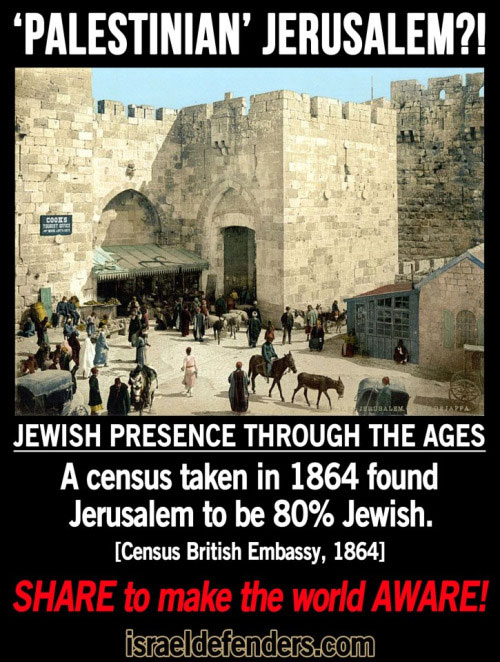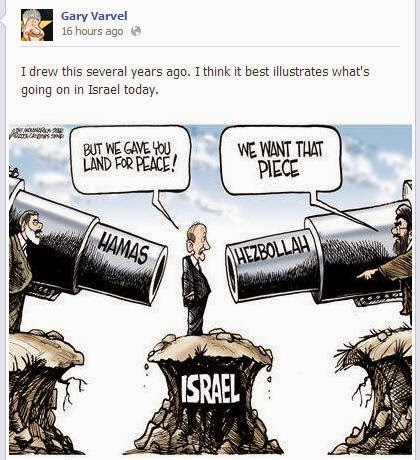In November 2014 the Israeli government dedicated November 30 of every year as a day to honor and remember the Jewish refugees who were expelled from Arab countries following 1948’s Arab-Israeli War. These are some of their stories |
|
|
|
“We disappeared.” The story of Jewish refugees from Arab lands The stories of the people who witnessed the end of Jewish life in their countries of origin, from Iraq to Libya, and were forced to start from scratch: the Jewish refugees from Arab lands. Jewish presence in Arab countries long predates Islam and the Arab conquest of the Middle East and goes back to Biblical times. According to official statistics, over 850,000 Jews were forced to leave their homes in Arab countries between 1948 and the early 1970s. Today, there are fewer than 7,000 Jews left. |
|
The Exile of Jews from Arab Lands – Noemi Lieberman |
|
 On December 1, 1947, two days after the U.N. General Assembly approved the Partition Plan, pogroms erupted in most Arab states. These pogroms were a result of the incitement in the state-run media in those countries, and was supposed serve as retribution for U.N. plan. The Arabs considered the partition to be a betrayal by the international community, and many in Arab world still hold that view today and refuse to accept the notion that the Jews should have a state. |
|
|
|
When they start killing Jews in the street, it is time to leave.Bernard-Henri Lévy — French philosopher, filmmaker, and activist warns American Jews; Bernard-Henri Lévy Says Election of Donald Trump a ‘Major Event for Jews’; Warns of Rise of ‘American Antisemitism’ |
|
From Jewish Virtual LibraryFact Sheet: Jewish Refugees from Arab Countries(Updated December 2015) http://www.jewishvirtuallibrary.org/jsource/talking/jew_refugees.html |
|
|
In 1945, roughly 1 million Jews lived peacefully in the various Arab states of the Middle East, many of them in communities that had existed for thousands of years. After the Arabs rejected the United Nations decision to partition Palestine and create a Jewish state, however, the Jews of the Arab lands became targets of their own governments’ anti-Zionist fervor. As Egypt’s delegate to the UN in 1947 chillingly told the General Assembly: “The lives of one million Jews in Muslim countries will be jeopardized by partition.” The dire warning quickly became the brutal reality. Throughout 1947 and 1948, Jews in Algeria, Egypt, Iraq, Libya, Morocco, Syria, and Yemen (Aden) were persecuted, their property and belongings were confiscated, and they were subjected to severe anti-Jewish riots instigated by the governments. In Iraq, Zionism was made a capital crime. In Syria, anti-Jewish pogroms erupted in Aleppo and the government froze all Jewish bank accounts. In Egypt, bombs were detonated in the Jewish quarter, killing dozens. In Algeria, anti-Jewish decrees were swiftly instituted and in Yemen, bloody pogroms led to the death of nearly 100 Jews. In January 1948, the president of the World Jewish Congress, Dr. Stephen Wise, appealed to U.S. Secretary of State George Marshall: “Between 800,000 and a million Jews in the Middle East and North Africa, exclusive of Palestine, are in ‘the greatest danger of destruction’ at the hands of Moslems being incited to holy war over the Partition of Palestine … Acts of violence already perpetrated, together with those contemplated, being clearly aimed at the total destruction of the Jews, constitute genocide, which under the resolutions of the General Assembly is a crime against humanity.” In May 1948, the New York Times echoed Wise’s appeal, and ran an article headlined, “Jews in Grave Danger in all Muslim Lands: Nine Hundred Thousand in Africa and Asia face wrath of their foes.” With their lives in danger and the situation growing ever more perilous, the Jews of the Arab World fled their homes as refugees. Of the 820,000 Jewish refugees between 1948 and 1972, more than 200,000 found refuge in Europe and North America while 586,000 were resettled in Israel – at great expense to the Israeli government, and without any compensation from the Arab governments who had confiscated their possessions. The majority of the Jewish refugees left their homes penniless and destitute and with nothing more than the shirts on their backs. These Jews, however, had no desire to be repatriated in the Arab World and little is heard about them because they did not remain refugees for long. In Israel, a newly independent country that was still facing existential threats to its survival, the influx of immigrants nearly doubled the population and a put a great strain on an economy struggling to just meet the needs of its existing population. The Jewish State, however, never considered turning away the refugees and, over the years, worked to absorb them into society. |
|
Overall, the number of Jews fleeing Arab countries for Israel in the years following Israel’s independence was nearly double the number of Arabs leaving Palestine. The contrast between the Jewish refugees and the Palestinian refugees grows even starker considering the difference in cultural and geographic dislocation – most of the Jewish refugees traveled hundreds or thousands of miles to a tiny country whose inhabitants spoke a different language and lived with a vastly different culture. Most Palestinian refugees traveled but a few miles to the other side of the 1949 armistice lines while remaining inside a linguistically, culturally and ethnically similar society. Moreover, the value of Jewish property left behind and confiscated by the Arab governments is estimated to be at least 50 percent higher than the total value of assets lost by the Palestinian refugees. In the 1950’s, John Measham Berncastle, under the aegis of the United Nations Conciliation Commission for Palestine, estimated that total assets lost by Palestinian refugees from 1948 – including land, buildings, movable property, and frozen bank accounts – amounted to roughly $350 million ($650 per refugee). Adding in an additional $100 million for assets lost by Palestinian refugees as a result of the Six Day War, an approximate total is $450 million – $4.4 billion in 2012 prices. By contrast, the value of assets lost by the Jewish refugees – compiled by a similar methodology – is estimated at $700 million – roughly $6.7 billion today. … |
|
Old Historians, New Historians, No Historians: The Derailed Debate on 1948 |
Why was there no UNRWA for our grandparents?
In the 1950’s, there were nearly 1 million #Jewish refugees from Yemen, Syria, Iraq, Tunisia, Libya, Algeria, and Egypt We, also, still have the keys 🗝
|
|
One year later — the answer to “Where Are Your Jews?”
“Mr. President, one year ago in this chamber I asked the Arab states a simple question: ‘Where are your Jews?’ My question was met with dead silence. Millions of people worldwide watched the video, witnessing for themselves the hypocrisy and double standards that characterizes much of what is said and done here. Today I have come to provide the answer to my question. Algeria, Iraq, Syria, Egypt, Lebanon, Yemen, Libya—your Jews fled as refugees after suffering persecution and deadly pogroms like the Farhud of Baghdad in 1941. Fortunately, countries like Israel, the U.S., Canada, France and others opened their doors, offering citizenship and equal rights. These Jewish refugees from Arab lands—whose suffering and losses the UN has never addressed—put their hardship behind them and built great lives for their families. Now let us contrast this with the situation of those descended from Arab refugees who fled the area of British Mandatory Palestine during the invasion of nascent Israel by Arab armies. What is holding them back? The answer is simple. Palestinians are the only population in the world not eligible for services by the UN refugee agency (@Refugees). Instead these descendants are governed by @UNRWA, which holds generation after generation trapped in refugee camps, denied integration in the Arab countries they were born in and denied resettlement elsewhere. Some of UNRWA’s donors are waking up to the problem. As Swiss Foreign Minister @ignaziocassis recently has put it: ‘By supporting UNRWA, we are only keeping the conflict alive.’ I thank you, Mr. President.” – @HillelNeuer
|
|
The hidden Jews in Mashad, Iran
In 1839, thousands of Muslims viciously attacked the #Jewish ghetto of Mashad in a bloody pogrom known as the “Allahdad” (Gd’s Justice). 36 Jews were slaughtered. Many women were raped. 7 Jewish girls were kidnapped and forced to become child-brides. The remaining 300 Jewish families were given an impossible choice: convert to Islam, or die immediately. Like the Marrano Jews of Spain who pretended to convert to Catholicism while hiding their true Jewish identity, the 300 Jewish families in Mashad – including my best friend’s family – pretended to convert. Outside their homes, by all appearances, Mashadi Jews truly converted. They adopted Muslim But at home, in their basements and behind shuttered windows, they secretly continued to devoutly observe Judaism. Shabbat candles – which were made secretly in their basements – were lit under a cover, so they couldn’t be seen through windows. Women would wear traditional Muslim clothes – called chador – but would clandestinely use those cloaks to smuggle Torahs, prayer shawls and other ceremonial objects throughout the community. Families kept dogs and cats, so they could feed them the Muslim meat they bought while they themselves ate kosher meat, ritually slaughtered in secret and smuggled home under the women’s chadors. During Passover, women would bake Matzah in basements after the children were sleeping, so if the children were ever questioned by Shia fanatics (which was common) they wouldn’t have any information to divulge. And to keep their children from intermarrying, children were betrothed at a young age, so if Muslims came asking for their hand, they would be told the girls were already engaged. For 120 years Mashadi Jews prayed that the day would come when they would be able to live freely as Jews. They suffered a secret double life, filled with fear, because they had no way to escape the radical Muslims who wanted to oppress, persecute and erase Jews from existence. But today’s Jews are finally free. Today’s Jews have our ancestral indigenous homeland #Israel. Today’s Jews know that the #October7Massacre is just another rinse and repeat of bloody pogroms like the “Allahdad” where Jews are slaughtered, raped and looted to satisfy antisemitic blood lust. This war isn’t about land. It was NEVER about land. It’s about a genocidal desire to destroy Jews from existence. 🔥AND WE ARE GOING NOWHERE🔥 #AmYisraelChai
My ancestors had to hide their Judaism in Mashad, Iran. They survived by practicing Islam and would even make the Hajj, pilgrimage, to Mecca (which is where the “Haj” comes from in my family name). Despite that, my family stayed true to our roots and kept our Judaism alive. I am proud to belong to an ancestry who fought to stay Jewish. I am proud to be Mashadi and belong to a sisterhood of Iranian women who are fighting for their freedom. And I am proud to call Israel my home. Thank you @persianjewess for sharing our story
|
|
Many of my aunts and uncles didn’t flee Iran quickly. What happened to them
They were older. They had multiple children. And they had established lives with businesses and homes. In many ways, they were also hopeful. “Maybe it won’t be so bad,” they thought. They were wrong. Seemingly overnight, the #Jewish schools my cousins attended fell under a new administration. Jewish teachers were fired and replaced with radicals loyal to the Islamic Regime. Each day in class, my cousins – some as young as 5 – and all their Jewish classmates had to stand up and recite “Death to America!” “Death to Israel!” as part of their morning ritual. If a child didn’t scream these phrases loud enough to the satisfaction of their sadistic teachers, they were punished. Parents were interrogated. If their answers weren’t satisfactory, they were imprisoned as “Zionist spies.” So the Jewish children made sure to scream these calls for death as loud as they could, to save their parents the wrath of the goons of the IRGC. And then, right on the heels of the Islamic Revolution, came the Iran-Iraq War and with it, the indoctrination of child soldiers into martyrdom. The IRGC drafted young boys, some as young as 9 years old, for mine-sweeping and other suicide missions. The children were given plastic ‘keys to paradise’ and promised that they would go directly to heaven if they died as martyrs against the Iraqi enemy. 9 out of 10 Iranian child soldiers died. An estimated 95,000 child soldiers were sacrificed by the Iranian Regime. My oldest cousin was 14. My aunt and uncle, desperate to save their son, scraped together what money they had to hire smugglers to sneak him out of Iran. The journey would take 2 weeks, with zero communication, and fraught with danger. Thousands who sought to escape via the smugglers never made it to their destination: killed or captured along the way. Their bodies lost to the desert. But staying was certain death. And so they sent off my 14 year old cousin by himself, praying they would be one of the lucky ones who would receive a phone call from their son in two weeks time once he reached Pakistan. It would be years before my aunt and uncle would be reunited with my cousin again. Today, we see the same sickening disregard for human life being carried out by the Islamic Regime’s proxy: Hamas. Islam is distorted and perverted to indoctrinate children into martyrdom and terrorism. Islamic Jihad and murder for the sake of “Allah” is glorified. Democratic countries like the #USA and #Israel are vilified. Because Hamas doesn’t care for Palestinians. Hamas is no more than Iran’s puppet. And Iran’s end goal is not Palestinian statehood, but the spread of radical Islam via the destruction of democracy. Israel, the only bastion of democracy in the Middle East, is just the Islamic Regime’s first target. This was NEVER about land. This was ALWAYS about the destruction of western values. And the war is already on our shores, in our schools, and in every violent Pro-Hamas protest we see in the streets. So 🔥WAKE UP AMERICA🔥 It’s time to smell the Jihad. Before it’s too late. #StandWithIsrael
|
|
I have yet to see a Middle Eastern ‘AsAJew’
Many “western” Jews have spent generations living in the comfort of tolerant democratic societies. Their experience of persecution no more than an anecdotal story told about their Bubbe. Their connection with their Jewish identity no more than the act of eating a bagel with lox and shmear. What do the Chuck Schumers and the Jonathan Glazers of the world really know about living in continuous fear because they are #Jewish? Nothing. Because a fear so suffocating that it imbeds every moment of your existence cannot be described in mere words. Our minds, quite literally, are incapable of comprehending such a trauma. All my relatives have Arab/Farsi names, and secret Jewish names. Are those words sufficient to help you taste the bitter helplessness of my relatives who had to hide their Jewish identity? My friend’s great-aunts, from Kermanshah, were kidnapped from their homes and forced into marriages with mullahs, never to be seen again. Does that sentence make you feel the same shaking rage that her grandmother experiences to this day? My parents were forced to abandon their lives, their homes, their belongings, pack a few precious possessions into a suitcase, and flee Iran after the Islamic Revolution. Is that enough for you to experience my parent’s heartbreak as they left everything and everyone they loved behind because of radical jihadist terrorists? The answer is No. But the 1.2 Million Jews who were ethnically cleansed from the Middle East since the 1940’s don’t need to rely on inadequate anecdotal tales. We know, FIRST HAND, what it means to be persecuted for being Jewish. We know, what it means to have to flee your country, with nowhere to go except Israel. And most important of all, we know that it was solely because of the existence of #Israel that we were finally able to flee the persecution of MENA countries and seek better lives. We don’t need to “hijack the Holocaust” to justify the existence of Israel. Our own lived experiences are MORE THAN SUFFICIENT to justify the existence of Israel. And we know, without question, that the Jewish State is all that stands between a life as persecuted Dhimmis and a life as Free Jews. So go ahead and tokenize the Jonathan Glazers of the world who pretend that Jewish persecution began and ended with the Holocaust. Go ahead and pretend that Mizrahi Jews and the centuries of discrimination, forced conversions, rape, murder and ethnic cleansing don’t exist. Keep acting like this is about land and not about the rampant Jew-Hate that has existed in MENA countries since the dawn of Islam. This #ZionistJew will scream loud enough for the WHOLE WORLD to hear me. 🔥I STAND WITH ISRAEL🔥 Now and forever. 💙🇮🇱💙 #AmYisraelChai
|
|
I was in my ELEMENT on Purim
I was an olive-skinned, dark-haired girl living in a world where Disney princesses had blonde hair and blue eyes and NOTHING around me reflected the reality of my personal life. As the only Persian kid at school, my teachers didn’t know where “I-ran” was on a map, let alone how to help an immigrant kid who was constantly bullied for being different. And even Hebrew school, which focused on Ashkenazi traditions, was always slightly off from my Jewish life at home. We would learn about the Holocaust and “Never Again,” and while my American classmates would go home with the confidence that their existential place in the world was assured…I’d be left even more confused. How is it Never Again if my family had to flee Iran for being #Jewish just a few short years ago? Their “Never Again” didn’t match with my “Never Again”. Was this another one of those things that was different between Ashkenazis and Mizrahis, like eating rice on Passover? The teachers never really had an answer. No one wanted to be the adult who told a class full of kids that yes, people on the world still want you dead because you are Jewish. But on Purim. I was in my ELEMENT on Purim. Fuck Cinderella. And Fuck Sleeping Beauty. They were nothing more than weak damsels waiting for a prince to save them. Queen Esther, with her bravery, beauty, and sharp wit not only saved herself, she saved her ENTIRE people. I’d put on my prettiest dress, let down my brown hair, plop a plastic crown on my head and OWN my role as one of the greatest female icons in history. “My family is from Persia, like Queen Esther,” I’d tell my Hebrew school class with pride. And for once, I wasn’t on the outside looking in. With my belly full of Hamantaschen and my ears ringing with the sound of groggers, I’d feel seen. But today, it’s not enough. I can’t put on a Queen Esther costume and overlook the fact that for Persian and MENA Jews, and many Jews from the post WW2 Soviet Block, the promise of “Never Again” never applied. Jewish persecution DIDN’T end in 1948. I hear so many Jewish voices say they were “blindsided” by antisemitism. The only reason they were “blindsided” was because post-WW2 Jewish persecution outside of #Israel, especially in MENA countries, has been overlooked and outright ignored. The Nazism that resulted in the Holocaust wasn’t destroyed, it was REBRANDED into Radical Islamic Jihadism. And the same Radical Islamic Jihadist ideology that forced 1.2 MILLION MENA Jews out of their homes is the one embraced by HMS and its many supporters now. This is why Pro-HMS groups have erased the existence of MENA Jews from their narrative altogether. After all, it’s impossible to continue the LIE of “colonial oppressor vs Arab oppressed” when faced with the complete ETHNIC CLEANSING of Jews from Yemen, Syria, Afghanistan, Saudi Arabia, Iran, Morocco, Iraq, and all the other MENA countries. So this Purim, as you celebrate Queen Esther, don’t forget… MENA Jewish history is more than a story in the Megillah. And we need ALL our collective voices and experiences to defeat the hateful Nazi/Jihadists once and for all. 💙🇮🇱💙 #AmYisraelChai #StandWithIsrael
|


